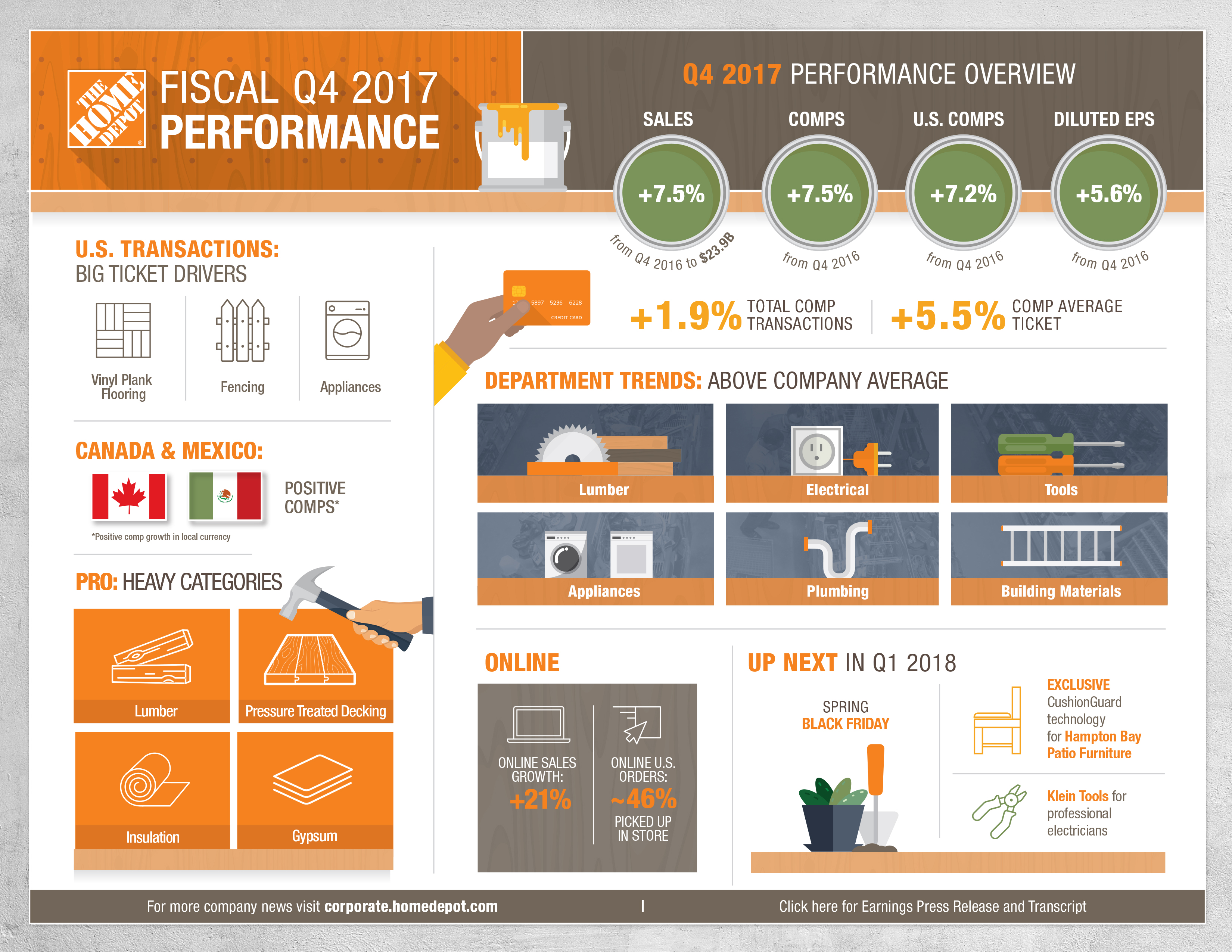Home Depot Inc The Forecasted To Earn Q4 2017 Earnings Of 1 35 Per Share Hd
The Home Depot Inc., a formidable giant in the home improvement retail sector, is on the precipice of unveiling its anticipated earnings report for the fourth quarter of 2017. Analysts project that the company will post earnings per share (EPS) of $1.35, a figure that reflects not only the brand's resilience in a competitive market but also its ability to adapt to shifting consumer demands and economic pressures. This projected growth merits a closer examination of the factors driving Home Depot’s performance and the implications for its stakeholders.

In recent years, Home Depot has solidified its status as a leader in the home improvement industry, propelled by a robust business model that intertwines brick-and-mortar stores with a thriving e-commerce presence. The transition towards digital has been particularly salient, especially with consumers increasingly gravitating toward online shopping for convenience and variety. Home Depot has indeed harnessed this trend, enhancing its online platform while also ensuring that inventory management across its physical locations is seamless and efficient.
The forthcoming Q4 earnings announcement is significant as it not only encapsulates the holiday season’s impact—an essential period for retail—but also serves as a barometer for the company’s overall health during a fiscal year that many considered robust. The holiday shopping season generally ushers in heightened consumer spending, and Home Depot, with its extensive range of products, from DIY essentials to seasonal merchandise, is ideally positioned to capitalize on this trend. The forecasted EPS reflects not merely the sales of physical products but also the strategic promotions and innovative marketing campaigns that have characterized Home Depot’s recent efforts.
Additionally, an exploration of the economic landscape reveals several factors that may influence earnings performance. Consumer confidence has been gradually recovering, buoyed by a stable employment rate and incremental wage growth. This resurgence in confidence is particularly crucial for Home Depot, as it often correlates with increased spending on home improvement projects—not just renovations but also upgrades and maintenance. As homeowners seek to enhance their living spaces, Home Depot stands to benefit from an uptick in transactions fueled by a revitalized economic environment.
Moreover, the company has made significant strides in enhancing customer experience which, combined with technological innovations, might amplify the anticipated earnings. The implementation of advanced data analytics allows Home Depot to better understand customer preferences and purchasing behaviors, enabling more personalized shopping experiences. This analytical approach not only helps in managing inventory but also tailors marketing efforts to resonate more profoundly with various customer segments.
The omnichannel strategy adopted by Home Depot has also proven advantageous. By providing customers with the option to buy online and pick up in-store, or to have products delivered directly to their homes, the company caters to varying shopping preferences. Such flexibility is not merely a logistical convenience; it builds customer loyalty and encourages repeat business, which are fundamental to long-term profitability.
Furthermore, Home Depot's commitment to enhancing its product assortment plays a pivotal role in its earnings forecast. The company has adeptly expanded its array of offerings, particularly in areas like appliances and outdoor living, segments that are witnessing robust growth. As consumers continue to invest in their homes, the diversity of products available at Home Depot—ranging from tools to décor—positions the retailer advantageously against competitors.
However, challenges remain on the horizon. The competitive nature of the home improvement sector cannot be understated, with rivals also ramping up efforts to capture market share. The potential for price wars or aggressive marketing campaigns from competitors is an ever-present threat that could impact Home Depot’s margins. The current retail landscape, fostering omnichannel experiences, has led to a race where customer experience often supersedes traditional metrics of success.
In addition to external competition, the macroeconomic climate continues to evolve, particularly with interest rates potentially influencing consumer borrowing and spending patterns. Higher mortgage rates could dampen housing activity, which traditionally propels demand for home improvement products and services. Thus, although forecasts for Q4 earnings are optimistic, external economic forces could alter the trajectory, necessitating close attention from investors and analysts alike.
In summation, as Home Depot prepares to disclose its Q4 2017 earnings report, the anticipated earnings of $1.35 per share symbolizes much more than mere numbers on a ledger. It embodies the culmination of strategic initiatives, adaptive marketing strategies, and a responsive supply chain that interlink to form a resilient business model. While optimism surrounds the forthcoming earnings announcement, stakeholders must remain cognizant of the evolving market dynamics that could influence future performance. Home Depot’s ability to navigate these challenges while capitalizing on growth opportunities will be pivotal in defining its path forward in the ever-competitive landscape of home improvement retail.
Post a Comment